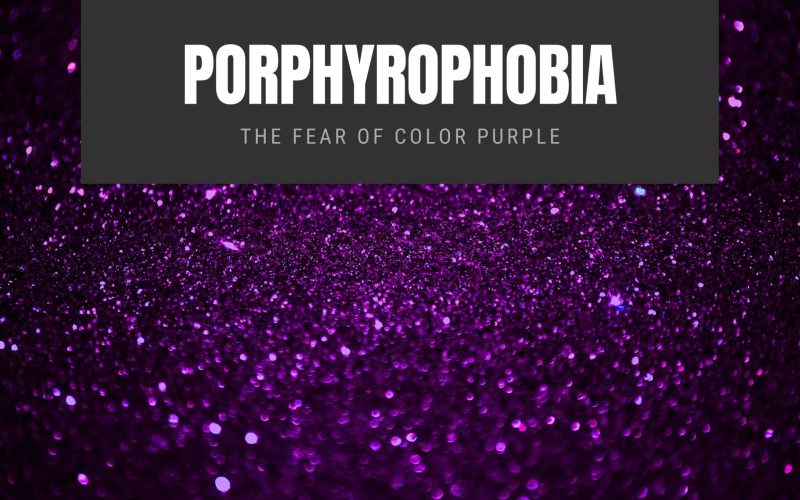Porphyrophobia may not be familiar, but it’s real. Colors make life more enjoyable. People can spend hours looking at a rainbow because of its beauty with its seven hues.
However, in the same way, people have favorite colors; it is possible to have an intense fear of a specific color.
Do you know anyone who hates The Color Purple? If you do, such a person has porphyrophobia.
What is Porphyrophobia?
Porphyrophobia is the intense and irrational fear of the color purple. Any person who suffers from this condition will likely suffer high amounts of anxiety when they see the color purple or when they think about it.
As a matter of fact, the anxiety people with a fear of purple phobia may experience can be so intense that it results in a full-blown panic attack.
Porphyrophobia falls into the category of specific phobias because the cause of fear is identifiable.
Nevertheless, it is essential to note that not everybody will experience such intense panic attacks.
Someone who suffers a full-blown panic attack due to their fear of the color purple can expect to experience increased heart rate, higher blood pressure, increased rate of breathing, trembling, muscle tension, excessive sweating, and other symptoms.
It is quite common for people who suffer from porphyrophobia to avoid the color purple as much as possible.
They may avoid places painted with the color purple, avoid putting on clothes with that color, and avoid situations that would expose them to the color in any way.
This intense fear causes them to be excessively worried and engage in irrational thinking about the worst things that can happen when exposed to the objects of their fear.
Symptoms of Porphyrophobia
Just as is the case with every other phobia that exists, people who have an irrational fear of the color purple may experience symptoms that mimic those of other mental health conditions. One of the most common symptoms is anxiety attacks.
Depending on how severe a person’s panic attack is, they may have to be hospitalized. Below are some of the most notable symptoms of prophyrophobia:
Constantly avoiding places and people that may expose you to The Color Purple
- Anxiety of the thoughts of the color purple
- Panic attacks
- Muscle tension
- Always sweating and shaking in the presence of the color purple
Causes of Porphyrophobia
There are no specific causes of porphyrophobia. Some of the likely causes include environmental factors and genetics.
For instance, if a person has a family history of specific phobias anxiety disorders or other mental illnesses, they have a higher chance of dealing with the fear of color purple.
When a person has such a genetic predisposition, all it requires to trigger this phobia could be a simple exposure or a traumatic event involving the purple color.
Because there are no identified causes of this phobia, your mental health professional would have to explore the above factors (genetics and environment) to conclude on a possible cause of your phobia.
When a likely cause has been identified, the next step is to explore possible treatment options with the patient and determine which would best suit the symptoms that the patient experiences.
Treatment Options for Porphyrophobia
Fear of color purple phobia or porphyrophobia has no specific treatment. Just like all the other phobias, several treatment methods can be used to combat this fear.
However, the treatment method that a mental health professional chooses to use depends on the individual and the symptoms that they report.
Some of the treatment methods that can be explored include cognitive behavioral therapy, exposure therapy, and some psychiatric medications.
Exposure Therapy
Exposure therapy is one of the most popular methods for treating specific phobias like fear of the color purple.
This treatment method is self-explanatory. It involves a therapist gradually exposing a patient to the object of their fear in a safe environment.
In the case of a specific phobia like porphyrophobia, a therapist will have to begin by gradually exposing the patients to objects with the color purple that can be observed.
Once the patient starts to get comfortable looking at purple objects, they can proceed to the next stage, which requires them to touch objects of that color. This process is called desensitization through repetitive exposure.
Theoretically, the more a patient is exposed to the object of their fear in a safe environment, the less bothersome the object of Fear becomes over time.
Cognitive-behavioral Therapy
This method of treatment for phobias is more commonly used for people dealing with obsessive-compulsive disorders or general anxiety disorders.
However, for a person dealing with the fear of the color purple, this method of treatment, also known as talk therapy, will help them understand why they feel, think, or behave the way they do whenever they’re in the presence of purple objects.
This method of treatment aims to help the patient understand why they behave the way they do and see reasons why they should behave otherwise.
Here, a patient realizes that their fears are irrational and that the object they fear is actually harmless.
Cognitive-behavioral therapies are usually very short sessions and have also proven to be an effective method of treating phobias.
Medication
Most people who have phobias are of the opinion that medications will work faster than therapy. However, no medication has been specially designed for the treatment of any phobia.
Therapists would usually advise against the use of medicines as they are typically short-term fixes, or rather, management plans for phobia symptoms.
Most of the medications prescribed for people with a phobia are those used for the treatment of other mental health conditions, such as anxiety.
Final Thoughts on Porphyrophobia
Porphyrophobia is not one of the most widespread fears, and for this reason, people who have it may be too ashamed to speak up.
Knowing that your worries are imperative and finding a lasting solution would help you live healthier.
For the fear of the color purple to be classified as a phobia, it must have existed for longer than six months and also affect essential aspects of the sufferer’s life.
If you find yourself avoiding work, school, or other important activities because you don’t want to be exposed to the color purple, then it is time to seek help from a mental health professional.








